Representatives of the Chinese Nationalist Party (KMT) and the Taiwan People’s Party (TPP) yesterday held their first formal meeting in Taipei to form a “blue-white alliance” for next year’s presidential election, but the two sides only agreed to hold public debates, while no consensus was reached on how a single presidential candidate would be chosen or a timetable for a potential deal.
KMT Secretary-General Justin Huang (黃健庭) and King Pu-tsung (金溥聰), executive officer of the office of the KMT’s presidential candidate, New Taipei City Mayor Hou You-yi (侯友宜), met with former Taipei deputy mayor Vivian Huang (黃珊珊), who is campaign manager for the TPP’s candidate, its chairman and former Taipei mayor Ko Wen-je (柯文哲), and Vincent Chou (周榆修), Ko’s campaign office director.
A recording was made of the three-hour meeting, and news conferences were held before and after.
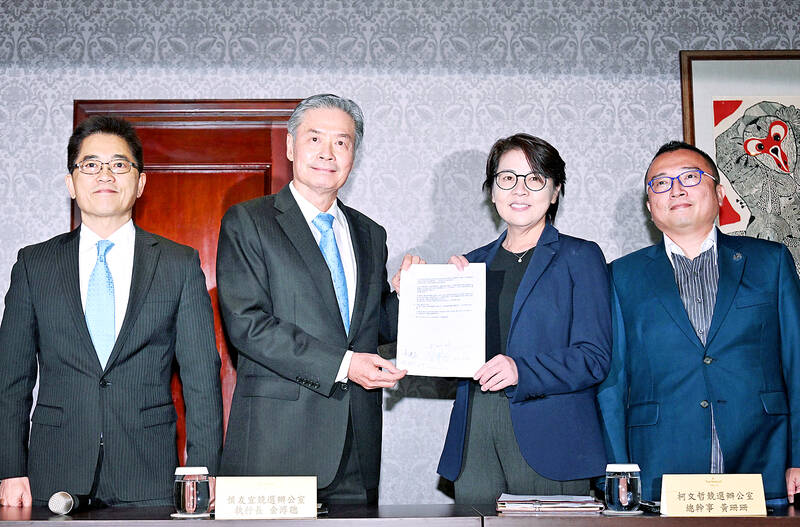
Photo: Fang Pin-chao, Taipei Times
The TPP suggested that opinion polls should be used to determine who is the strongest candidate.
The polls — conducted by five agencies — should be conducted half via landline interviews and half via cellphone, the TPP said.
The polls should compare the favorability of the KMT and TPP candidates against top candidates from other parties, with a decision made by averaging the results, it said.
The KMT proposed a primary system, such as those used in France and the US, with voting stations across Taiwan that would allow people to say which candidate they prefer.
Voters would be required to show their identification card and sign a form saying they approve of opposition parties working together to remove the Democratic Progressive Party (DPP) from power, it said.
The two parties’ representatives said that once a method to pick the strongest candidate is decided, the candidates would attend three televised debates.
The TPP said it hopes a decision could be made by Oct. 31 on the method to pick the strongest candidate and how the three debates should be conducted, while the KMT said it preferred a Nov. 10 deadline.
The KMT representatives said that the party agrees with four of Ko’s seven main political ideals, while partially agreeing or differing on the other three.
A TPP proposal that the president should report to the legislature was one of the three the KMT said it had concerns about, saying it doubted the value of the president being questioned by caucuses.
While it agreed that the premier should be approved by legislators, it had doubts about the legitimacy of ministers requiring legislator approval, the KMT said.
It did not agree to freezing the Control Yuan and the Examination Yuan, it added.
Regarding four reforms proposed by Hou, the TPP agreed with a push for absentee voting, and adding climate justice and environmental rights to the Constitution, but was reserved about establishing a new special investigation division and diverges with Hou over national identity policy.
Hou proposes a national identity policy of maintaining democracy and freedom; protecting the Republic of China (ROC); opposing Taiwanese independence; opposition to a hypothetical invasion of Taiwan; and opposing “one country, two systems,” with Taiwan’s future to be decided by its 23 million people.
The TPP said it would preserve the ROC’s democracy and freedom, conform to the Constitution and oppose unilateral changes to the “status quo.”
Separately, DPP spokesman Chang Chih-hao (張志豪) said that the two parties had hidden agendas.
They are calculating how to split political benefits, Chang said.
Vice President William Lai (賴清德), the DPP’s presidential candidate, is prepared, but said the TPP and the KMT are fomenting panic.
Lai has been responsible, proposing the main directions for Taiwan’s future, including a four-pillar plan for peace, he said.
“Regrettably, many people pretend they did not hear Lai, especially Hou and Ko, who have continued their war rhetoric, which is intended to cause panic and insecurity,” he added.
Additional reporting by Chen Cheng-yu
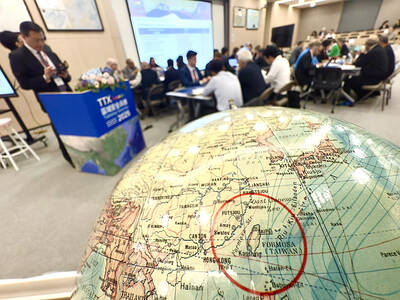
DEFENSE: The National Security Bureau promised to expand communication and intelligence cooperation with global partners and enhance its strategic analytical skills China has not only increased military exercises and “gray zone” tactics against Taiwan this year, but also continues to recruit military personnel for espionage, the National Security Bureau (NSB) said yesterday in a report to the Legislative Yuan. The bureau submitted the report ahead of NSB Director-General Tsai Ming-yen’s (蔡明彥) appearance before the Foreign and National Defense Committee today. Last year, the Chinese People’s Liberation Army (PLA) conducted “Joint Sword-2024A and B” military exercises targeting Taiwan and carried out 40 combat readiness patrols, the bureau said. In addition, Chinese military aircraft entered Taiwan’s airspace 3,070 times last year, up about
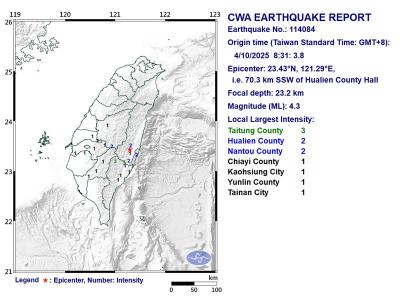
A magnitude 4.3 earthquake struck eastern Taiwan's Hualien County at 8:31am today, according to the Central Weather Administration (CWA). The epicenter of the temblor was located in Hualien County, about 70.3 kilometers south southwest of Hualien County Hall, at a depth of 23.2km, according to the administration. There were no immediate reports of damage resulting from the quake. The earthquake's intensity, which gauges the actual effect of a temblor, was highest in Taitung County, where it measured 3 on Taiwan's 7-tier intensity scale. The quake also measured an intensity of 2 in Hualien and Nantou counties, the CWA said.
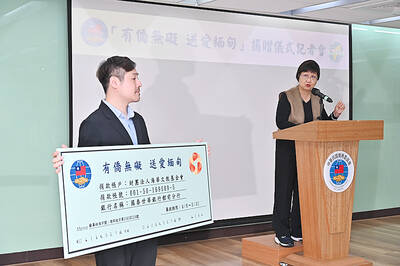
The Overseas Community Affairs Council (OCAC) yesterday announced a fundraising campaign to support survivors of the magnitude 7.7 earthquake that struck Myanmar on March 28, with two prayer events scheduled in Taipei and Taichung later this week. “While initial rescue operations have concluded [in Myanmar], many survivors are now facing increasingly difficult living conditions,” OCAC Minister Hsu Chia-ching (徐佳青) told a news conference in Taipei. The fundraising campaign, which runs through May 31, is focused on supporting the reconstruction of damaged overseas compatriot schools, assisting students from Myanmar in Taiwan, and providing essential items, such as drinking water, food and medical supplies,
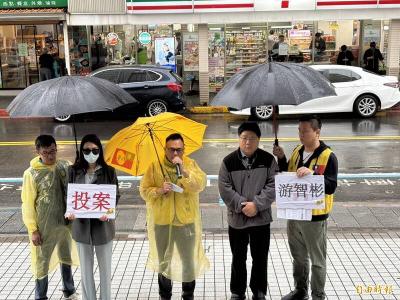
New Party Deputy Secretary-General You Chih-pin (游智彬) this morning went to the National Immigration Agency (NIA) to “turn himself in” after being notified that he had failed to provide proof of having renounced his Chinese household registration. He was one of more than 10,000 naturalized Taiwanese citizens from China who were informed by the NIA that their Taiwanese citizenship might be revoked if they fail to provide the proof in three months, people familiar with the matter said. You said he has proof that he had renounced his Chinese household registration and demanded the NIA provide proof that he still had Chinese